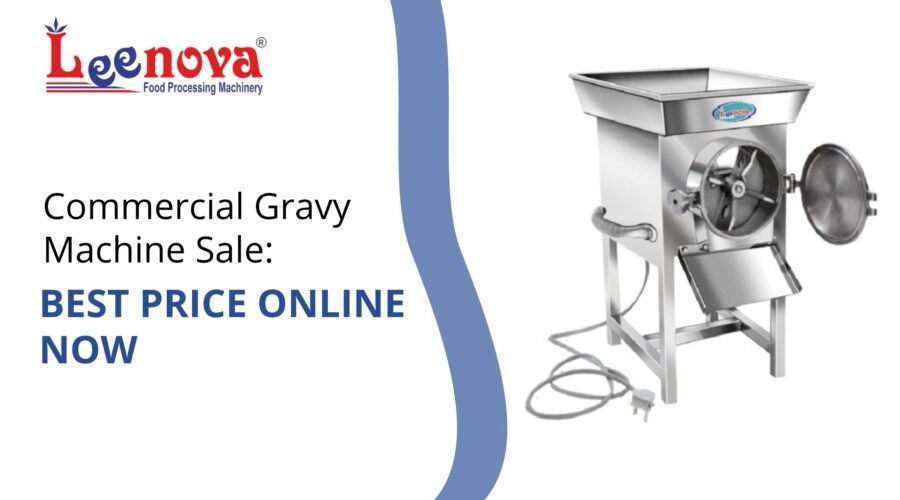Restaurant kitchens lose an average of 3-4 hours daily on manual grinding. Chefs chop, grind, and blend onions, tomatoes, ginger, and garlic by hand or with undersized equipment that struggles during peak service. A commercial gravy machine eliminates that bottleneck. As a kitchen equipment manufacturer since 2006, we design gravy machines that process 35-50 kg of ingredients per hour while maintaining texture and freshness. This guide explains what commercial gravy machines do, which capacity fits different operations, how pricing works, and what features justify the investment.
What Is a Commercial Gravy Machine?
A commercial gravy machine grinds wet ingredients into smooth gravies, pastes, and chutneys for restaurant cooking. Unlike dry pulverizers, these machines handle moisture-rich materials like tomatoes, onions, ginger, garlic, green chilies, and leafy vegetables without jamming or overheating.
The machine uses a motor-driven grinding chamber with rotating plates. Ingredients enter through the top hopper, pass between grinding surfaces, and exit as paste or gravy through a discharge outlet. Plate gap adjustment controls texture from coarse to fine.
Most commercial models run on single-phase 220-240V power, making them compatible with standard kitchen electrical setups. The grinding chamber typically measures 6-9 inches in diameter, and processing capacity ranges from 10 kg/hour for small operations to 500 kg/hour for industrial kitchens.
Benefits That Transform Kitchen Operations
Speed and Consistency
A 2 HP gravy machine processes 35-40 kg of ingredients per hour. Manual grinding takes 15-20 minutes per kilogram. That machine completes in 90 seconds what takes a chef 20 minutes, freeing labor for other tasks.
Consistency matters for taste. Machine grinding produces uniform particle size batch after batch. Manual grinding varies with operator fatigue and technique, creating inconsistent flavor profiles that customers notice.
Freshness Preservation
Pre-ground pastes oxidize and lose aroma within hours. Grinding on demand preserves volatile compounds that give authentic flavor to curries, masalas, and sauces. Restaurants report 30-40% improvement in customer feedback on flavor intensity when switching from stored paste to fresh grinding.
Labor Cost Reduction
One machine replaces 2-3 hours of manual prep work daily. At standard kitchen wages, that saves ₹15,000-20,000 monthly in labor costs. The equipment pays for itself within 3-4 months in mid-sized restaurants.
Types and Capacity Selection
Motor Power Determines Output
1 HP models handle 10-12 kg/hour, suitable for small restaurants serving 50-80 covers daily. The grinding chamber measures 6 inches, processing ginger-garlic paste, small batches of onion-tomato gravy, and herb chutneys.
2 HP machines process 35-40 kg/hour for restaurants serving 150-200 covers. They handle boiled onions at 30-32 kg/hour, dry chilies at 16-18 kg/hour, and almonds-cashews at 10-12 kg/hour. The 7×3 inch chamber accommodates medium-volume prep.
3 HP models reach 100-150 kg/hour capacity with 9-inch chambers. Hotels, catering services, and institutional kitchens use these for bulk gravy production during banquets and large events.
Single Phase vs Three Phase
Single-phase motors run on 220-240V household power without requiring industrial electrical infrastructure. They work for restaurants, cloud kitchens, and small food processors where three-phase supply isn’t available.
Three-phase motors deliver more power and efficiency at higher capacities (5-7.5 HP models processing 400-700 kg/hour). These suit industrial food processing units and central kitchens supplying multiple outlets.
Material Construction and Hygiene
Stainless steel construction costs 40-50% more than mild steel but prevents rust, corrosion, and metal contamination. Food-grade SS304 meets FSSAI requirements for commercial kitchens and passes health inspections without issues.
Mild steel models work in dry environments with proper maintenance. They suit operations on tight budgets where immediate cash flow matters more than long-term durability.
The grinding chamber design affects cleaning time. Removable plates and easy-access chambers reduce cleaning from 20 minutes to 5 minutes between ingredient changes. This prevents cross-contamination and maintains hygiene standards.
Price Range and Value Assessment
Market Pricing Breakdown
2 HP gravy machines retail at ₹12,000-15,000 depending on material and brand. Stainless steel models command ₹16,000-18,000. A 3 HP machine ranges ₹18,000-22,000.
The cheapest options start at ₹5,000-6,000 for basic 1 HP models with limited capacity. These suit very small operations or home-based catering. Industrial 7-7.5 HP models cost ₹95,000-110,000 for capacities exceeding 500 kg/hour.
What Justifies Higher Prices
Motor quality determines longevity. Premium motors run 8-10 hours daily for 8-12 years. Budget motors fail within 2-3 years of heavy use. Replacement costs ₹4,000-6,000 plus downtime during peak service.
Grinding plate material affects texture consistency. Hardened steel plates maintain sharp edges for 4-5 years. Soft metal plates dull within 12-18 months, producing coarse, uneven paste that affects dish quality.
Warranty coverage reveals manufacturer confidence. One-year motor warranties indicate quality construction. No warranty signals corner-cutting that leads to frequent repairs.
Essential Features to Prioritize
Chamber Size Match
A 6-inch chamber handles paste-style grinding for small batches. Ginger-garlic paste, herb chutneys, and dry spice grinding work well. Larger items like whole tomatoes or big onion pieces struggle in confined space.
A 9-inch chamber accommodates bulkier ingredients and faster processing. The extra diameter reduces jamming and improves flow, critical during high-volume prep for lunch and dinner service.
RPM and Grinding Speed
Most commercial gravy machines run at 2880 RPM, balancing speed with heat control. Excessive speed generates friction heat that cooks ingredients during grinding, affecting color and flavor. Proper RPM maintains raw texture while achieving fine consistency.
Automation Level
Semi-automatic models require manual feeding and monitoring. An operator loads ingredients continuously and adjusts plate gap as needed. This hands-on approach suits operations where prep staff multitask across various equipment.
Fully automatic models feature continuous feed systems with sensors that regulate flow and prevent overload. These suit dedicated prep stations in large kitchens where the machine runs for hours without operator intervention.
Operational Best Practices
Feed ingredients steadily, not in large dumps. Overloading jams the grinding chamber and strains the motor. Consistent flow produces smoother paste and extends machine life.
Run boiled ingredients through first when making complex gravies. Boiled onions and tomatoes grind faster and smoother than raw ones, reducing processing time by 35-40%.
Clean the grinding chamber immediately after use. Dried paste hardens and requires scraping, damaging plate surfaces. Warm water rinse while still wet takes 2-3 minutes and prevents buildup.
Check plate gap weekly. Loose plates produce coarse, inconsistent paste. Tight plates generate excess friction and heat. Proper gap maintains texture quality and prevents motor strain.
Why Material Quality Matters Long-Term
A survey of 200 commercial kitchens in Gujarat showed that mild steel gravy machines averaged 4.2 years of service life before replacement. Stainless steel units averaged 9.7 years. The higher initial cost spread over double the lifespan reduces annual equipment cost by 45%.
Corrosion creates food safety risks. Rust particles contaminate ingredients, causing metal taste in dishes and potential health violations during inspections. Replacing a failed health inspection costs more than buying quality equipment initially.
FAQs
Q: What ingredients can commercial gravy machines process?
A: Gravy machines handle tomatoes, onions, ginger, garlic, green chilies, almonds, cashews, peanuts, leafy greens, boiled pulses for dal vada, and similar wet or semi-dry ingredients. They work with both raw and pre-cooked materials for various gravies, pastes, and chutneys.
Q: How much power does a gravy machine consume?
A: A 2 HP gravy machine consumes approximately 1.5 kWh per hour of operation. At average commercial electricity rates of ₹8-10 per unit, running cost is ₹12-15 per hour, making it economical for daily use in commercial kitchens.
Q: Can one machine handle both dry and wet grinding?
A: Standard gravy machines are designed specifically for wet grinding. Using them for dry spices damages seals and creates dust that affects motor cooling. Separate pulverizers handle dry grinding. Some manufacturers offer combination models, but dedicated machines perform better.
Q: What is the typical warranty coverage?
A: Most commercial gravy machines include one-year motor warranty covering manufacturing defects. This does not cover damage from misuse, overloading, or improper maintenance. Extended warranties are available at additional cost.
Q: How do I choose between 2 HP and 3 HP capacity?
A: Calculate daily grinding volume. If processing under 150 kg daily, a 2 HP model suffices. Operations grinding 200+ kg daily need 3 HP capacity to avoid overworking the motor. Match capacity to actual usage patterns, not peak-day scenarios.
Conclusion
Commercial gravy machines reduce prep time by 70-80%, improve consistency, preserve freshness, and free kitchen staff for higher-value tasks. Selecting the right capacity, material construction, and features for specific needs determines return on investment.
Leenova Kitchen Equipment manufactures gravy machines built for commercial kitchen demands. Our 2 HP model processes 35-40 kg/hour with 7×3 inch grinding chambers, single-phase 220-240V motors, and one-year warranty coverage. We build both mild steel and stainless steel versions for different budget levels and durability requirements.
Since 2006, we’ve supplied food processing equipment to restaurants, hotels, and catering operations across India. Our gravy machines feature semi-automatic operation, standard electrical compatibility, and straightforward maintenance that keeps kitchens running during peak service.
Get the best price on commercial gravy machines designed for your kitchen capacity. Contact Leenova Kitchen Equipments today for specifications, pricing, and delivery details on gravy machines that transform your prep workflow.


